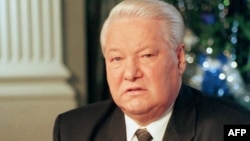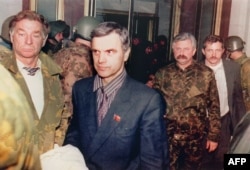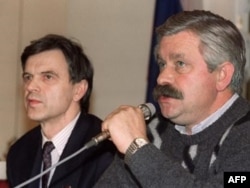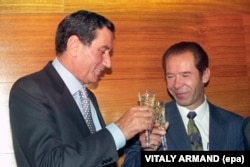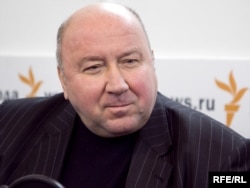MOSCOW -- It brought Russia to the brink of civil war and resulted in the worst street violence in Moscow since the 1917 Bolshevik Revolution.
Thirty years ago, on October 4, 1993, months of political conflict climaxed when President Boris Yeltsin ordered the army to shell and storm the country's legislature.
Since the collapse of the Soviet Union, the country had been riven by a fundamental conflict between the leftists in parliament and the right-centrist, free-market reformers in Yeltsin’s government. The much-amended and fatally outdated 1978 Soviet Constitution offered no way out of the mounting standoff.
Yeltsin ordered the disbanding of the parliament, the Supreme Soviet, on September 21 and called for new elections. But under the leadership of Yeltsin's chief rivals, Supreme Soviet speaker Ruslan Khasbulatov and Vice President Aleksandr Rutskoi, rebel lawmakers barricaded themselves in Moscow's White House -- the building housing parliament -- and voted to impeach the president over what they regarded as an illegal order.
The country fell into a dangerous dual-power situation.
Yeltsin responded by isolating the building, surrounding it with police and cutting off electricity, telephones, and water.
When Khasbulatov and Rutskoi incited armed gangs of anti-Yeltsin protesters to attack the Ostankino television studio, the nerve center of Russia's broadcast media, and the Moscow mayor's office, Yeltsin declared a state of emergency and ordered a military assault on the Supreme Soviet.
RFE/RL takes a look at some of the key players in these events, which in many ways set the stage for the course Russia took over the following decades.
The President: Boris Yeltsin
He was the unlikely hero of Russia's perestroika-era democratic movement. In the late 1980s, Boris Yeltsin transformed himself from regional Communist Party boss to populist firebrand. This metamorphosis climaxed with the iconic image of Yeltsin standing on a tank and facing down a hard-line coup in front of the Moscow White House in August 1991 -- which precipitated the breakup of the Soviet Union and catapulted Yeltsin into the Kremlin.
But by the spring of 1993, the luster of those heady days was wearing thin.
Russia's post-Soviet economy was mired in crisis as Yeltsin's market reforms, known as shock therapy, were increasingly unpopular. Throughout the second half of 1992, the legislature refused to confirm economist Yegor Gaidar as Yeltin’s choice for prime minister. In a compromise move, Yeltsin nominated former Gazprom head Viktor Chernomyrdin instead and he was confirmed in December 1992.
Yeltsin performed well in an April 1993 referendum on his rule. But as the summer wore on, he found himself increasingly in conflict with the Supreme Soviet, its speaker, Ruslan Khasbulatov, and his own vice president, Aleksandr Rutskoi.
With gridlock and confrontation paralyzing the country, Yeltsin on September 21, 1993, signed Decree No. 1400, which dissolved the legislature and set elections for a new bicameral parliament for December.
Yeltsin’s move contravened several articles of the Soviet-era constitution then in effect, which Yeltsin and his supporters had long argued was so hopelessly outdated and extensively amended that the new country desperately needed a new one. Yeltsin based his decree on the fact that nearly two-thirds of Russians in the April referendum had voted in favor of immediate parliamentary elections.
The president claimed the move was necessary to carry out needed economic reforms, establish a market economy, and prevent a return to the Soviet past.
When legislators barricaded themselves in the Moscow White House and impeached Yeltsin, he ignored them and cut off electricity, phone service, and hot water to the building.
Clashes broke out between police and anti-Yeltsin protesters, who set up barricades in the capital. When demonstrators attacked the Ostankino TV tower and the Moscow mayor's office, Yeltsin ordered the Interior Ministry to declare a state of emergency.
And in the early hours of October 4, Yeltsin reportedly ordered Defense Minister Pavel Grachev to have his troops shell and storm the White House. By midday, troops loyal to Yeltsin had managed to secure the building and arrest the rebel lawmakers.
Three months later, a new constitution was approved in a national referendum, giving the president enormous powers that the office maintains to this day.
Yeltsin won a second term as president in a controversial election in 1996. His health had deteriorated, and the Kremlin became embroiled in a series of corruption scandals. Yeltsin unexpectedly resigned on New Year's Eve 1999, turning power over to his prime minister and chosen successor, former KGB officer Vladimir Putin, who has since used the powers of the presidency to steer Russia in a more authoritarian direction.
Yeltsin died in 2007.
Sergei Filatov, the president's chief of staff in October 2003, reflected on the crisis in a 2013 interview with RFE/RL's Russian Service:
"Most important, of course, is in that fight with the opposition all contact was lost between the president and the parliament. Confidence between each other was completely lost. And most importantly, there was strong interference in the efforts to carry out economic reforms.
"It wasn't just Yeltsin who had the sickness. We all had that Soviet, imperial mentality, where strength will always better solve the problem as opposed to negotiations and compromise. It was a sickness of Yeltsin, it was a sickness of [former Soviet leader Mikhail] Gorbachev -- it was a sickness we all had. It wasn't an accident that we always supported the forceful option in solving this or that issue, which means that we didn't grow up to the level of ability to solve issues by peaceful means.
"We survived that time and we should have learned something from it, but unfortunately, we didn't learn anything. For the last 20 years, we've acted with the same methods -- without agreement, attention, or understanding of public opinion and all actions are used by the authorities, which constitutionally can use their power to preserve a normal state for society. But it's not always good. If we're headed to a democratic society, we need to change our methods of managing the country and the methods of interaction with elements of power."
The Speaker: Ruslan Khasbulatov
An economist of Chechen origin, Khasbulatov was a close ally of Yeltsin's in the waning days of the Soviet Union. He was elected to Soviet Russia's Congress of People's Deputies in 1990 and backed Yeltsin in his resistance to the failed hard-line coup in August 1991.
After the Soviet breakup, Khasbulatov was elected speaker of the Supreme Soviet, where he quickly consolidated power.
He also began to fall out with Yeltsin over policy differences, most notably Yeltsin's pursuit of so-called shock therapy to establish a market economy. This quickly escalated into a bitter power struggle between the two men and their supporters.
In September 1993, Khasbulatov publicly denounced the president as an alcoholic and called for his resignation. After Yeltsin's decree to dissolve the legislature, Khasbulatov gathered rebel lawmakers in the White House, where they voted to impeach Yeltsin and install Vice President Aleksandr Rutskoi as president.
Addressing supporters from the balcony of the White House, Khasbulatov urged them to storm the Kremlin and imprison "the criminal usurper Yeltsin."
After the storming and shelling of the White House on October 4, Khasbulatov was arrested. In 1994, the newly elected parliament, the State Duma, amnestied him and other leaders of the anti-Yeltsin resistance.
He left politics and taught economics at the Plekhanov Russian Academy of Economics in Moscow. He died in January 2023.
Speaking to RFE/RL's Russian Service in 2013, Khasbulatov indicated that he believed his position in the fall of 1993 had been vindicated by subsequent events:
"An unconstitutional, criminal decree was issued on September 21. But before that, the executive branch had devised a plot to overthrow the existing political system. On September 21, they began implementing that plot through a military coup.
"The only option we had left was to launch an impeachment procedure, in accordance with the constitution, and to submit both the presidential decree and our decision for consideration by the Constitutional Court. Need I remind you what the Constitutional Court decided? The Constitutional Court, under the leadership of Valery Zorkin, who is still the court's chairman, ruled that Yeltsin's decree was illegal and that parliament had the right to impeach him.
"Yeltsin and his entourage committed a grave crime against the state. This should be the subject of a new parliamentary investigation. We need a new commission to investigate it, without any haste, and bring this issue to a close.
"Yeltsin received support when he shelled the parliament, but do you see what kind of constitution we have now? It's not just a constitution, it's a super-constitution. Nobody has any power in our country except the president. You can't even sneeze without his permission. And that is a direct consequence of what happened back then."
The Vice President: Aleksandr Rutskoi
A decorated Afghan war veteran, Yeltsin chose Rutskoi as his running mate in 1991 when he successfully ran for president of the Soviet Union's Russian republic.
Like Khasbulatov, he was on Yeltsin's side during the failed August 1991 coup. And like Khasbulatov, he fell out with Yeltsin and his team after the Soviet collapse. He was particularly critical of the team of young economists, including Yegor Gaidar and Anatoly Chubais, whom Yeltsin tapped to spearhead his economic reforms.
Beginning in late 1992, Rutskoi began accusing Yeltsin and his entourage of corruption. As head of a state anticorruption council, Rutskoi famously claimed to have "suitcases of kompromat," or incriminating materials, on them.
In September 1993, after Yeltsin evicted Rutskoi from his Kremlin office and had the door sealed, Khasbulatov gave him space in the parliament building.
After Yeltsin dissolved parliament and the rebel lawmakers voted to impeach him, Rutskoi was sworn in as "acting president." Speaking with Khasbulatov from the balcony of the White House on October 3, Rutskoi called on protesters in Moscow to storm the Ostankino TV station and the mayor's office, setting off the chain of events that led to the shelling of the White House.
Rutskoi was arrested together with Khasbulatov and other leaders of the rebellion and charged with inciting mass disturbances. He was freed in an amnesty the following year.
Rutskoi formed a nationalist political party, Derzhava, and in 1996 was elected governor of Kursk Oblast, serving until 2000. He has since left public life.
He spoke to RFE/RL's Russian Service in 2013:
"For 18 years we've been given a series of lies about the events of 1993. But in the past two years, the seeds of truth have begun to sprout. I strongly support this for two reasons: not to settle scores with anyone, but to let people know the truth about these tragic events so they're never repeated. Because it's a fratricidal war.
"This is purely a principled position: so no one would ever think and no one would ever say that I cast aside Yeltsin from his chair and rushed to power. I wanted just one thing: that economic reforms were not in the interests of a list in Forbes [magazine] but in the interest of the population. Tragically, I was right -- this was the consequence of the privatization: The impoverishment of the population was total -- we lost our industrial, agricultural, and military capacities.
"When it's said that there was a constitutional crisis, there was no such thing. All Yeltsin's legislative initiatives were, in accordance with the constitution, introduced and decided on in the Congress of People's Deputies."
The Would-Be Prime Minister: Yegor Gaidar
In June 1992, Yeltsin named 36-year-old liberal economist Yegor Gaidar as prime minister. He advocated a radical and painful program of rapid economic liberalization known as “shock therapy” that polarized the country. The legislature repeatedly refused to confirm him as prime minister over the summer of 1992, producing the most visible symbol of the split between the two branches of government.
In December 1992, as part of a bid to reach a compromise with the Supreme Soviet, Yeltsin nominated former Gazprom head Viktor Chernomyrdin as premier and he was confirmed. Gaidar continued as a leading economic adviser to the government. In September 1993, in what was seen as a deliberate snub of the legislature, Gaidar was appointed first deputy prime minister overseeing economic policy.
On October 3, shortly after Khasbulatov and Rutskoi called on their supporters to storm Ostankino and the mayor’s office in the capital, Gaidar appeared on TV, speaking from a remote studio because of the heavy fighting outside Ostankino, and urged ordinary citizens to come out into the streets and support Russia’s reforms despite the presence of numerous snipers across the capital. He said that if Khasbulatov and Rutskoi prevailed, Russia would be “turned into an enormous concentration camp for decades.”
In the December 1993 Duma elections, Gaidar headed the progovernment Russia’s Choice party. In a time when government-allied parties in Russia could still lose elections, Russia’s Choice polled just 15.51 percent, losing to nationalist Vladimir Zhirinovsky’s Liberal Democratic Party of Russia (LDPR) and barely beating Gennady Zyuganov’s Communist Party.
Gaidar resigned from government in 1994 and returned to academic life. He remains widely reviled among the Russian public.
He died in 2009 at the age of 53. Vladimir Putin, who was prime minister at the time, described Gaidar as “a genuine citizen and patriot.”
“He didn’t dodge responsibility and took his blows in the most challenging of situations with honor and courage,” Putin said.
The Radical: Viktor Anpilov
Viktor Anpilov was a hard-line communist member of the Supreme Soviet and one of the most radical and outspoken opponents of Yeltsin and his economic reforms. He maintained ties with the radical, anti-Semitic Pamyat movement and openly called himself a Stalinist.
He organized numerous mass demonstrations against Yeltsin in the 1991-93 period.
On October 3, Anpilov led his supporters to a mass demonstration outside the besieged parliament building. About 2,000 supporters showed up and broke through the barricades and into the area around the White House. There they joined forces with armed supporters of parliament inside and launched the assault on the mayor’s office and Ostankino.
Anpilov was arrested with the other leaders of the uprising on October 7 and was pardoned by the Duma in February 1994. He continued to participate in radical leftist politics until his death in January 2018 at the age of 72.
The Defense Minister: Pavel Grachev
As Yeltsin's standoff against Khasbulatov and Rutskoi careened toward violence, the role of the army became increasingly vital.
As a career soldier, Defense Minister Pavel Grachev rose through the military ranks and became head of the Soviet paratroopers in 1990. He backed Yeltsin during the thwarted hard-line coup of August 1991 and, according to some press reports, even warned him of the plot ahead of time.
And Yeltsin rewarded him handsomely. After the Soviet breakup, Grachev enjoyed a meteoric rise, becoming defense minister in May 1992.
As the constitutional crisis of 1993 unfolded, Grachev again demonstrated his loyalty to Yeltsin, ordering his troops to shell and storm the White House. Footage taken at the time showed Grachev praising his troops for saving Russia from a civil war.
Just weeks after the storming of the White House, Grachev was made a member of Yeltsin's powerful Security Council and decorated for "personal courage."
But in the coming years he would be dogged by allegations of corruption, earning the moniker "Pasha Mercedes." Grachev's reputation additionally suffered when Dmitry Kholodov, a 27-year-old journalist at the daily Moskovsky Komsomolets, was killed by a booby-trapped briefcase after publishing a series of articles on corruption in the Defense Ministry.
In the halls of power, Grachev also became part of the so-called party of war, a group of advisers -- including presidential security chief Aleksandr Korzhakov, Federal Security Service (FSB) chief Mikhail Barsukov, and First Deputy Prime Minister Oleg Soskovets -- who reportedly persuaded Yeltsin to launch his disastrous military campaign in breakaway Chechnya in 1994.
Grachev was fired in July 1996, shortly after Yeltsin won a second term in the Kremlin, in a move seen at the time as a purge of Kremlin hard-liners. He worked as an adviser to Russia's state arms exporter until 2007.
Grachev died in September 2012 at the age of 64.
The Interior Minister: Viktor Yerin
Just as with the army, the role of the police and Interior Ministry forces was central to how Yeltsin's conflict with the parliament played out.
Interior Minister Viktor Yerin was a career police officer, a veteran of the Afghan war, and a Yeltsin loyalist.
On October 1, in the midst of the standoff, Yeltsin promoted him to the rank of general and, afterward, awarded him with the title "Hero of the Russian Federation."
Yerin was forced to resign as interior minister in June 1995 after a failed attempt to rescue hostages taken by Chechen rebel leader Shamil Basayev in Budyonnovsk, in southern Russia. He served as deputy head of Russia's Foreign Intelligence Service (SVR) until 2000 and then faded from public life.
He died in March 2008 at the age of 64.
The Bodyguard: Aleksandr Korzhakov
Aleksandr Korzhakov was Yeltsin's chief bodyguard, confidant, and reportedly, his drinking buddy.
A career KGB man, Korzhakov hailed from the security agency's 9th Division, which was tasked with guarding high officials. In the 1980s, he was assigned to Yeltsin when the future president was a rising party star who had just been named first secretary of the Moscow Communist Party, essentially the capital's mayor.
When Yeltsin was removed from office after criticizing the slow pace of Gorbachev's reforms, Korzhakov stuck with him. And as Yeltsin ascended in the perestroika-era democratic movement, Korzhakov was by his side.
When Yeltsin got to the Kremlin, Korzhakov became head of the powerful Presidential Guard Service, wielding enormous behind-the-scenes influence.
Some observers say it was Korzhakov who ultimately convinced Yeltsin to shell and storm the White House. After the crisis of October 1993, Korzhakov's influence grew. Together with Grachev, he reportedly persuaded Yeltsin to send troops to breakaway Chechnya in 1994.
Korzhakov was fired in July 1996. In 1997, he published a memoir of his Kremlin years, titled Boris Yeltsin: From Dusk Till Dawn, in which he lambasted Yeltsin's entourage. He wrote that Yeltsin, before the October 1993 events, ordered him to prepare a plan to arrest all the members of the Supreme Soviet if they passed an impeachment resolution against the president. He also wrote that Yeltsin had looked into the possibility of using chemicals to “smoke out” the deputies who were barricaded in the White House.
He served as a deputy in the State Duma as an independent representative from Tula from 1997 to 2011.
The American: Terry Duncan
Terry Duncan, known by his middle name Mike, was an American lawyer who went out to the Ostankino firefight out of curiosity.
When fighting broke out and snipers began shooting into the crowd and at journalists, Duncan, 26, began helping wounded victims.
“He went back and forth several times, checking on people to see if they were OK,” said Otto Pohl, a New York Times photographer who was shot that day and was one of the people assisted by Duncan.
Duncan was shot in the head and killed during the firefight.
He had been in Moscow just a few months, working to set up a new law firm with a partner, Jamison Firestone.
The firm they created, Firestone Duncan, later had another brush with tragedy in Russia. It was the firm that hired Russian lawyer and auditor Sergei Magnitsky, who died in Russian custody in November 2009, sparking a massive international campaign against human rights abuses in Putin’s Russia.





